Practice Free AZ-104 Exam Online Questions
You have an Azure subscription that contains two virtual machines named VM1 and VM2 You create an Azure load balancer.
You plan to create a load balancing rule that will load balance HTTPS traffic between VM1 and VM2.
Which two additional load balance resources should you create before you can create the load balancing rule? Each correct answer presents part of the solution MOTL Each correct selection 5 worth one point.
- A . a frontend IP address
- B . a backend pool
- C . a health probe
- D . an inbound NAT rule
- E . a virtual network
A,C
Explanation:
To create a load balancing rule that will load balance HTTPS traffic between VM1 and VM2, you need to create two additional load balance resources: a frontend IP address and a health probe.
A frontend IP address is the IP address that the clients use to access the load balancer. It can be either public or private, depending on the type of load balancer. A frontend IP address is required for any load balancing rule1.
A health probe is used to monitor the health and availability of the backend instances. It can be either TCP, HTTP, or HTTPS, depending on the protocol of the load balancing rule. A health probe is
required for any load balancing rule1.
A backend pool is a group of backend instances that receive the traffic from the load balancer. You already have a backend pool that contains VM1 and VM2, so you don’t need to create another one. An inbound NAT rule is used to forward traffic from a specific port on the frontend IP address to a specific port on a backend instance. It’s not required for a load balancing rule, but it can be used to access individual instances for troubleshooting or maintenance purposes1.
A virtual network is a logical isolation of Azure resources within a region. It’s not a load balance resource, but it’s required for creating an internal load balancer or connecting virtual machines to a load balancer2.
Note: This question is part of a series of questions that present the same scenario. Each question in the series contains a unique solution that might meet the stated goals. Some question sets might have more than one correct solution, while others might not have a correct solution.
After you answer a question in this section, you will NOT be able to return to it. As a result, these questions will not appear in the review screen.
You have an app named App1 that is installed on two Azure virtual machines named VM1 and VM2.
Connections to App1 are managed by using an Azure Load Balancer.
The effective network security configurations for VM2 are shown in the following exhibit.
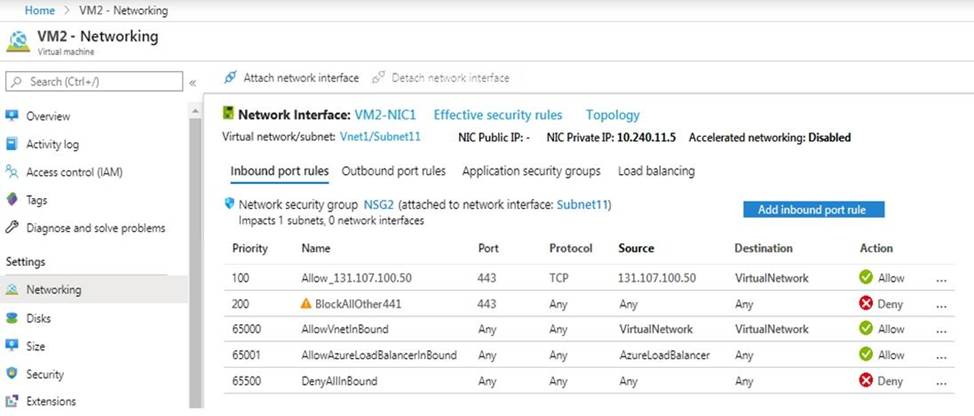
You discover that connections to App1 from 131.107.100.50 over TCP port 443 fail. You verify that the Load Balancer rules are configured correctly.
You need to ensure that connections to App1 can be established successfully from 131.107.100.50 over TCP port 443.
Solution: You create an inbound security rule that denies all traffic from the 131.107.100.50 source and has a cost of 64999.
Does this meet the goal?
- A . Yes
- B . No
You plan to automate the deployment of a virtual machine scale set that uses the Windows Server 2016 Datacenter image.
You need to ensure that when the scale set virtual machines are provisioned, they have web server
components installed.
Which two actions should you perform? Each correct answer presents part of the solution. NOTE Each correct selection is worth one point.
- A . Modify the extension Profile section of the Azure Resource Manager template.
- B . Create a new virtual machine scale set in the Azure portal.
- C . Create an Azure policy.
- D . Create an automation account.
- E . Upload a configuration script.
A,B
Explanation:
To automate the deployment of a virtual machine scale set that uses the Windows Server 2016 Datacenter image and has web server components installed, you need to perform the following actions:
Modify the extension Profile section of the Azure Resource Manager template. This section defines the extensions that are applied to the scale set virtual machines after they are provisioned. You can use the Custom Script Extension to run PowerShell scripts that install and configure the web server components. For more information, see Deploy an application to an Azure Virtual Machine Scale Set1.
Upload a configuration script. This is the PowerShell script that contains the commands to install and configure the web server components. You can upload the script to a storage account or a GitHub repository, and then reference it in the extension Profile section of the template. For an example of a configuration script, see Tutorial: Install applications in Virtual Machine Scale Sets with Azure PowerShell2.
Your on-premises network contains a VPN gateway.
You have an Azure subscription that contains the resources shown in the following table.

You need to ensure that all the traffic from VM1 to storage! travels across the Microsoft backbone network.
What should you configure?
- A . private endpoints
- B . Azure Firewall
- C . Azure AD Application Proxy
- D . Azure Peering Service
B
Explanation:
Per the MS documentation, private endpoint seems to be the proper choice: "You can use private endpoints for your Azure Storage accounts to allow clients on a virtual network (VNet) to securely access data over a Private Link. The private endpoint uses a separate IP address from the VNet address space for each storage account service. Network traffic between the clients on the VNet and the storage account traverses over the VNet and a private link on the Microsoft backbone network, eliminating exposure from the public internet." Link: https://learn.microsoft.com/en-us/azure/storage/common/storage-private-endpoints
You have an Azure subscription that contains the virtual machines shown in the following table. javascript:void(0)

You deploy a load balancer that has the following configurations:
• Name: LB1
• Type internal
• SKU: Standard
• Virtual network VNET1
You need to ensure that you can add VM1 and VM2 to the backend pool of LB1.
Solution: You create a Basic SKU public IP address, associate the address to the network interface of VM1, and then start VM1.
Does this meet the goal?
- A . Yes
- B . No
B
Explanation:
You can only attach virtual machines that are in the same location and on the same virtual network as the LB. Virtual machines must have a standard SKU public IP or no public IP.
The LB needs to be a standard SKU to accept individual VMs outside an availability set or vmss. VMs do not need to have public IPs but if they do have them they have to be standard SKU. Vms can only be from a single network. When they don’t have a public IP they are assigned an ephemeral IP.
Also, when adding them to a backend pool, it doesn’t matter in which status are the VMs.
Note: Load balancer and the public IP address SKU must match when you use them with public IP addresses.
Which blade should you instruct the finance department auditors to use?
- A . invoices
- B . partner information
- C . cost analysis
- D . External services
C
Explanation:
Cost analysis: Correct Option
In cost analysis blade of Azure, you can see all the detail for custom time span. You can use this to determine expenditure of last few day, weeks, and month. Below options are available in Cost analysis blade for filtering information by time span: last 7 days, last 30 days, and custom date range. Choosing the first option (last 7 days) auditors can view the costs by time span.
Cost analysis shows data for the current month by default. Use the date selector to switch to common date ranges quickly. Examples include the last seven days, the last month, the current year, or a custom date range. Pay-as-you-go subscriptions also include date ranges based on your billing period, which isn’t bound to the calendar month, like the current billing period or last invoice. Use the <PREVIOUS and NEXT> links at the top of the menu to jump to the previous or next period, respectively. For example, <PREVIOUS will switch from the Last 7 days to 8-14 days ago or 15-21 days ago.

Invoice: Incorrect Option
Invoices can only be used for past billing periods not for current billing period, i.e. if your requirement is to know the last week’s cost then that also not filled by invoices because Azure generates invoice at the end of the month. Even though Invoices have custom timespan, but when you put in dates for a week, the pane would be empty.
Below is from Microsoft document:
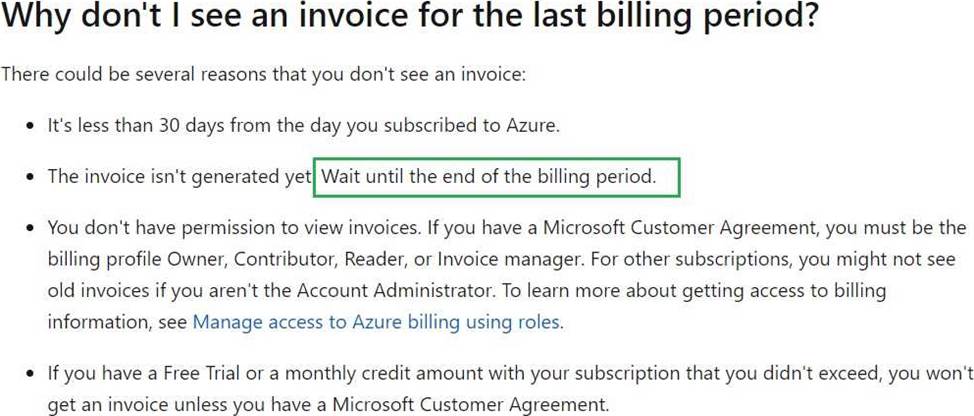
Resource Provider: Incorrect Option
When deploying resources, you frequently need to retrieve information about the resource providers and types. For example, if you want to store keys and secrets, you work with the Microsoft.KeyVault resource provider. This resource provider offers a resource type called vaults for creating the key vault. This is not useful for reviewing all Azure costs from the past week which is required for audit.
Payment method: Incorrect Option
Payment methods is not useful for reviewing all Azure costs from the past week which is required for audit.
Reference:
https://docs.microsoft.com/en-us/azure/cost-management-billing/costs/quick-acm-cost-analysis
https://docs.microsoft.com/en-us/azure/cost-management-billing/manage/download-azure-invoice-daily-usage-date
Note: This question is part of a series of questions that present the same scenario. Each question in the series contains a unique solution that might meet the stated goals. Some question sets might
have more than one correct solution, while others might not have a correct solution.
After you answer a question in this section, you will NOT be able to return to it. As a result, these questions will not appear in the review screen.
You have an Azure Active Directory (Azure AD) tenant named Adatum and an Azure Subscription named Subscription1. Adatum contains a group named Developers. Subscription1 contains a resource group named Dev.
You need to provide the Developers group with the ability to create Azure logic apps in the Dev resource group.
Solution: On Dev, you assign the Logic App Operator role to the Developers group.
Does this meet the goal?
- A . Yes
- B . No
B
Explanation:
The Logic App Operator role only grants the ability to read, enable, disable, and run logic apps. It does not grant the ability to create logic apps. To create logic apps, you need to assign the Logic App Contributor role or a higher-level role such as Owner or Contributor.
Then, Reference: [Built-in roles for Azure resources] [Azure Logic Apps permissions and access control]
HOTSPOT
You have an Azure subscription that contains an Azure Availability Set named WEBPROD-AS-USE2 as shown in the following exhibit.
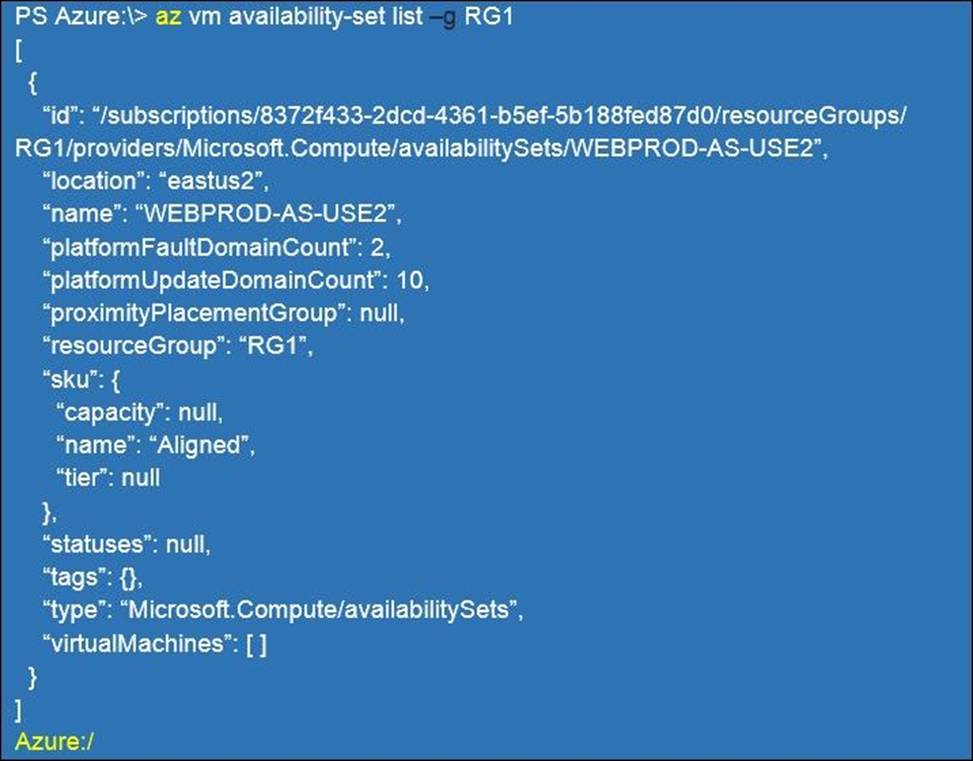
You add 14 virtual machines to WEBPROD-AS-USE2.
Use the drop-down menus to select the answer choice that completes each statement based on the information presented in the graphic. NOTE: Each correct selection is worth one point.
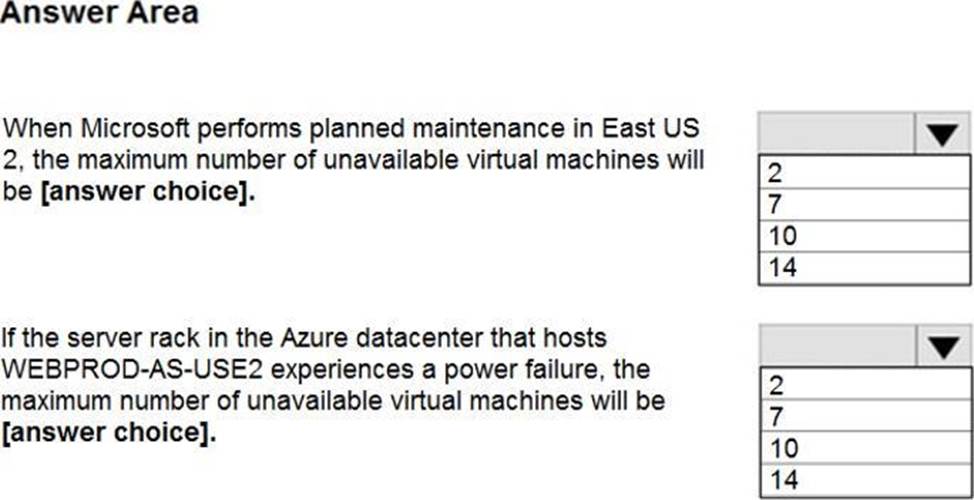
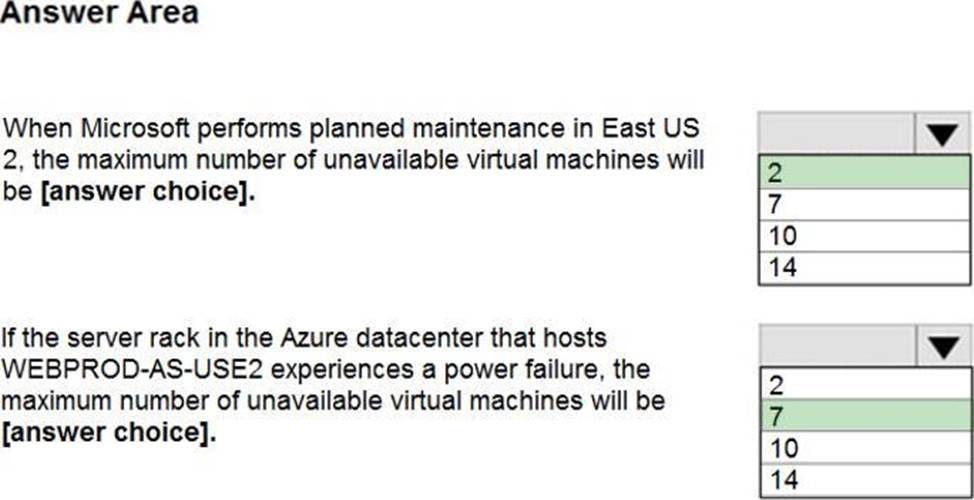
Explanation:
Box 1: 2
There are 10 update domains. The 14 VMs are shared across the 10 update domains so four update domains will have two VMs and six update domains will have one VM. Only one update domain is rebooted at a time.
Therefore, a maximum of two VMs will be offline.
Box 2: 7
There are 2 fault domains. The 14 VMs are shared across the 2 fault domains, so 7 VMs in each fault domain.
A rack failure will affect one fault domain so 7 VMs will be offline.
Reference: https://docs.microsoft.com/en-us/azure/virtual-machines/windows/manage-availability
HOTSPOT
You have an Azure subscription. The subscription contains virtual machines that run Windows Server 2016 and are configured as shown in the following table.

You create a public Azure DNS zone named adatum.com and a private Azure DNS zone named conioso.com.
You create a virtual network link for contoso.com as shown in the following exhibit.

For each of the following statements, select Yes if the statement is true. Otherwise, select No. NOTE: Each correct selection is worth one point.


Explanation:
All three VMs are in VNET2. Auto registration is enabled for private Azure DNS zone named contoso.com, which is linked to VNET2. So, VM1, VM2 and VM3 will auto-register their host records to contoso.com.
None of the VM will auto-register to the public Azure DNS zone named adatum.com. You cannot register private IPs on the internet (adatum.com)
Box 1: Yes
Auto registration is enabled for private Azure DNS zone named contoso.com.
Box 2: Yes
Auto registration is enabled for private Azure DNS zone named contoso.com.
Box 3: No
None of the VM will auto-register to the public Azure DNS zone named adatum.com
Reference:
https://docs.microsoft.com/en-us/azure/virtual-network/virtual-networks-name-resolution-for-vms-and-role-instances
https://docs.microsoft.com/en-us/azure/dns/private-dns-autoregistration
https://docs.microsoft.com/en-us/azure/dns/private-dns-virtual-network-links
You need to implement the planned changes for the storage account content.
Which containers and file shares can you use to organize the content?
- A . share1 only
- B . cont1 and share1 only
- C . share1 and share2 only
- D . cont1, share1, and share2 only
- E . cont1, cont2, share1, and share2
